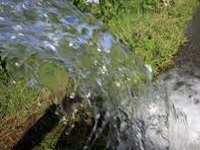 Many parts of the globe are fast becoming water-deficit or water-stressed in the wake of fast pace of ground water resources, #pollutionofsurfaceandgroundwater and owing to the vagaries of #climatechange culminating in the brisk melting of snow-clad glaciers. #Water is a finite resource and increasing demand for water in the wake of burgeoning #population, #urbanization and #industrialization is exerting additional stress on already limited #waterresources. Contamination of water resources further complicates the availability of #freshwater.
Many parts of the globe are fast becoming water-deficit or water-stressed in the wake of fast pace of ground water resources, #pollutionofsurfaceandgroundwater and owing to the vagaries of #climatechange culminating in the brisk melting of snow-clad glaciers. #Water is a finite resource and increasing demand for water in the wake of burgeoning #population, #urbanization and #industrialization is exerting additional stress on already limited #waterresources. Contamination of water resources further complicates the availability of #freshwater.
The Problem
Many experts are unanimous in their view that freshwater bodies are heavily affected by pollution, particularly by a range of #nutrients, #agrochemicals and pathogens from untreated #wastewater, and heavy metals from mining and industrial effluents.It is also pointed out that contaminated water is also more likely to host disease vectors, such as cholera-causing Vibrio and parasitic worm-transmitted schistosomiasis, also known as bilharzia. Contaminated water leads to serious impacts like changes to habitats and ecosystems, especially #wetlands; the loss of #aquaticbiodiversity; changes in species composition, #ecosystem functioning and service provision, including water quality improvement; the spread of waterborne diseases; changes in the productivity of #foodchains; and contamination and blockage of drainage by #plastics and other improperly managed #solidwaste. Besides, the increasing presence of pharmaceuticals, antimicrobials and new micro-pollutants in water are also emerging concerns.
According to broad estimates, over 80 per cent of the world’s #wastewater is released to the #environment without treatment.It is also estimated that globally about 58 per cent of diarrhoeal disease, a major driver of child mortality, is caused for want of access to #cleanwater and #sanitation.According to a recent #UNEP document, each year, 57 million years of life are lost or lived with disability due to poor water, #sanitation, #hygiene and #agriculturalpractices.
Severe pathogenic pollution of surface water resources in most of the developing countries entails the potential of putting at risk people’s health and endangering the use of #riverwater for #irrigation, #industry and other purposes. #Dischargeofuntreatedmunicipalwasteandindustrialwaste into surface and #groundwaterresources results in contamination of water and this problem is further compounded by strong seasonal variations in precipitation due to monsoons and inadequate water and wastewater treatment facilities.
This brings into focus the need for according primacy to #beatpollution, #wastewatermanagement for ensuring #environmentalsustainability and to ensuring access to clean water for all.However, this process of managing wastewater is confronted with some #stumblingblocks like #lackofeffectivemanagementofwatersources, #inadequatewatermonitoringtechnology, and lack of active participation of civil society.
Way Forward
Currently, the measurement of basic physical-chemical parameters is by far the most widespread application of on-site #waterquality instrumentation. However, this has to be supplemented with the use of multiparameter probes, which combine small sensors into a single submersible instrument. Another development is the arrival of the optical DO sensor. The advantage of all these systems is their long-term stability and low sensitivity to fouling, thus reducing maintenance, bringing down lifecycle costs while at the same time increasing up-time and reliability.
There is need to #improvewatergovernance and #strengthenwatergovernanceinstitutions, with added #emphasisoncollectionofwaterqualitymonitoringdata, its adequate compilation and synchronization. #Solarpowered watermonitoringinstruments with automatic cleaning systems and wireless communications interfaces for remote access and real-time data collection are becoming commonplace and enable deployment at remote, unmanned stations and in buoys. As more and more data are collected, handling and interpreting this information for management procedures would become easily accessible to formulate subsequent strategies.
Interventions to improve the #waterquality are generally implemented by #waterengineers. The #healthandsocialimpacts of these interventions areseldom assessed. There is increasing need to confront the dogmatism that current interventions represent improvement by allowing increased participation of the civil society. Increased participation of the civil society, apart from helping in evaluating the outcomes of interventions on water quality, will also be instrumental in identifying which interventions on water quality improve health and how these can be implemented at a large scale. Besides, civil society can help in #capacitybuildingofallstakeholders in keeping #waterresourcesfreefromcontamination.
By #DrArvindKumarPresidentIndiaWaterFoundation



